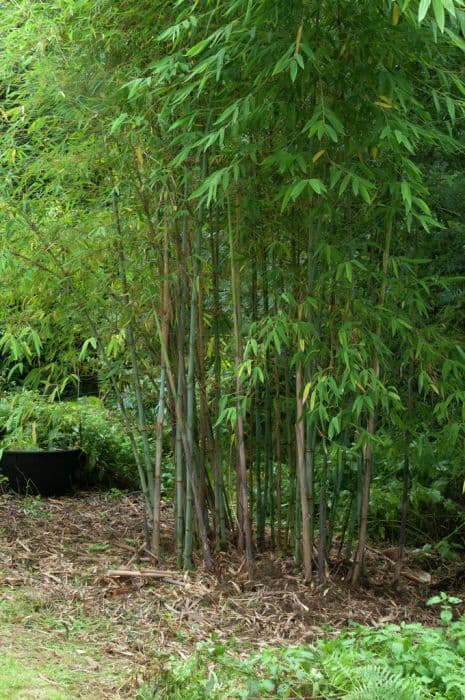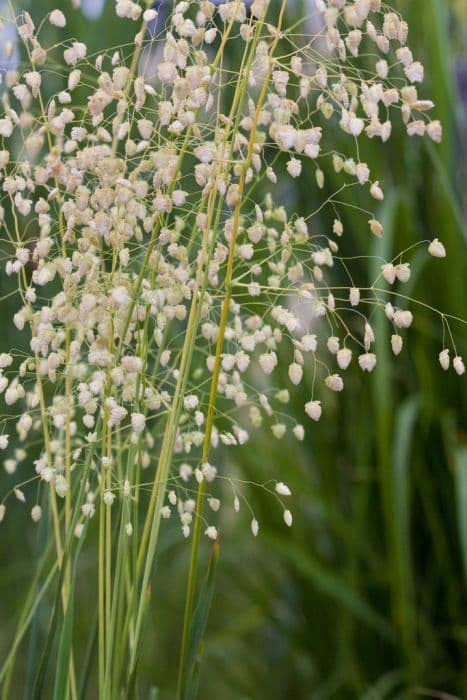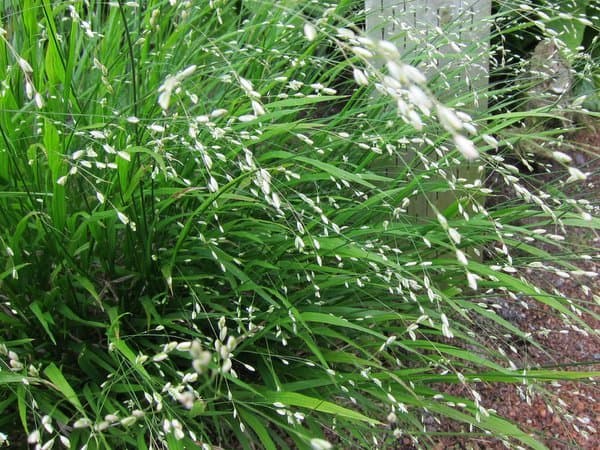Zebra Grass Miscanthus sinensis 'Zebrinus' (v)











ABOUT
Zebrinus, commonly known as Zebra Grass, is distinguished by its arching leaves decorated with horizontal bands of creamy yellow to ivory. These bands give it the appearance of a zebra's stripes, which is the inspiration behind both its common and cultivar names. Its foliage is a vibrant green that contrasts sharply with the lighter stripes, providing a striking visual texture in the landscape. As the season progresses, the leaves may take on pink or reddish hues, adding to the plant's visual interest. The plant also produces feathery plumes, usually in late summer or fall, which can be silver, pink, or reddish-brown, rising above the foliage and adding an extra layer of height and texture. These plumes persist through the winter, providing visual interest even when the garden is dormant. The overall form of Zebra Grass is upright with a tendency to arch, creating a graceful, fountain-like shape.
About this plant
 Names
NamesFamily
Poaceae
Synonyms
Zebra Grass, Chinese Silver Grass, Eulalia, Porcupine Grass
Common names
Miscanthus sinensis 'Zebrinus'
 Toxicity
ToxicityTo humans
Zebra grass is not known to be toxic to humans. Therefore, ingestion of this plant typically does not cause poisoning or toxic symptoms in people.
To pets
Zebra grass is not considered toxic to pets either. It is not known to cause poisoning in animals when parts of the plant are ingested, so there should be no toxic consequences under normal circumstances. However, ingestion of large amounts of plant material may cause gastrointestinal upset in some pets due to the plant's fibrous nature.
 Characteristics
CharacteristicsLife cycle
Perennials
Foliage type
Deciduous
Color of leaves
Variegated
Height
4-7 feet (1.2-2.1 meters)
Spread
3-6 feet (0.9-1.8 meters)
Plant type
Grass
Hardiness zones
5
Native area
Asia
Benefits
 General Benefits
General Benefits- Ornamental Value: 'Zebrinus' adds visual interest to landscapes with its variegated, striped foliage and feathery flower plumes.
- Drought Resistance: Once established, it is tolerant to drought, making it suitable for xeriscaping or gardens with low water availability.
- Low Maintenance: This grass requires minimal care once established and does not need frequent watering or fertilizing.
- Habitat Support: It provides shelter and food for wildlife, including birds who feed on its seeds.
- Erosion Control: The robust root system helps stabilize soil and prevent erosion on slopes or banks.
- Seasonal Interest: It provides year-round interest with changing foliage colors and textures across the seasons.
- Adaptability: Miscanthus sinensis 'Zebrinus' adapts well to a variety of soil types, though it prefers well-drained soil.
- Privacy Screen: Because of its height and density, it can be used as a natural privacy screen or to hide unsightly areas.
- Winter Interest: Even when dormant, the plant maintains structure and provides winter landscape interest with its tall, dry canes.
- Easy Propagation: It can be easily propagated by division, allowing gardeners to create new plants for other areas or to share with others.
 Medical Properties
Medical PropertiesThis plant is not used for medical purposes.
 Air-purifying Qualities
Air-purifying QualitiesThis plant is not specifically known for air purifying qualities.
 Other Uses
Other Uses- Miscanthus sinensis 'Zebrinus', commonly known as Zebra Grass, can be used in the production of paper due to its high cellulose content.
- The plant's fibrous stalks are suitable for making biodegradable pots or containers for young plants, reducing reliance on plastic.
- Zebra Grass can be utilized in crafted decorations, such as wreaths and arrangements, due to its unique striped foliage.
- The dried stems of Zebra Grass can be used in soundproofing applications because of their density and fibrous nature.
- When tightly packed, the dried plant material can serve as an eco-friendly packing material for shipping fragile items.
- Zebra Grass is occasionally used in the construction of eco-friendly furniture when combined with a binding agent.
- The robust stems can act as natural stakes in the garden for supporting other, less sturdy plants.
- It serves as a natural privacy screen or windbreak in the garden due to its height and dense growth.
- The plant can be used in handcrafted paper-making workshops as an educational tool to illustrate the use of fiber plants.
- Dried floral arrangements often incorporate Zebra Grass for its attractive texture and vertical element.
Interesting Facts
 Feng Shui
Feng ShuiThe Zebra Grass is not used in Feng Shui practice.
 Zodiac Sign Compitability
Zodiac Sign CompitabilityThe Zebra Grass is not used in astrology practice.
 Plant Symbolism
Plant Symbolism- Resilience: Zebra Grass is known for its hardiness and ability to thrive in a range of conditions, symbolizing the capacity to endure and overcome difficulties.
- Flexibility: The grass's long leaves that sway with the wind represent adaptability and the ability to bend without breaking in the face of change.
- Growth and Regeneration: As a perennial that returns each year and grows from its base, Zebra Grass is often associated with renewal and continuous growth.
- Balance: The signature stripes of Zebra Grass can symbolize balance and harmony, reflecting the plant's natural aesthetic of ordered patterns.
- Privacy: Often used as a screening plant in gardens, Zebra Grass can symbolize the protection of personal space and the creation of boundaries.
 Water
WaterZebra Grass should be watered deeply once a week, providing about 1 to 1.5 inches of water each time. During hot, dry periods, you may need to water twice a week. Ensure the soil is moist but not waterlogged, as Zebra Grass prefers consistent moisture. In the case of established plants, they can handle some drought but perform best when they are not stressed by lack of water. It's beneficial to water Zebra Grass in the morning to reduce evaporation and give the foliage time to dry out over the course of the day.
 Light
LightZebra Grass thrives in full sun, meaning it needs at least 6 hours of direct sunlight each day. It can tolerate some light shade, but its best growth and striping are achieved in sunnier spots. Avoid deep shade, as it can lead to poor growth and flopping.
 Temperature
TemperatureZebra Grass is hardy and can tolerate a wide range of temperatures but prefers conditions between 50°F and 75°F. It can survive minimum temperatures down to around -20°F and maximum temperatures well into the 90s°F. However, consistently extreme temperatures on either end can stress the plant.
 Pruning
PruningPruning Zebra Grass is mainly for aesthetic and plant health purposes. Cut back the foliage to about 4 inches above the ground in late winter or early spring before new growth starts. This helps to remove dead foliage, encourage new growth, and maintain the plant's form. Annually pruning is recommended; however, some gardeners also like to trim lightly during the growing season to shape the plant or remove any brown tips.
 Cleaning
CleaningAs needed
 Soil
SoilZebra Grass prefers a well-drained soil rich in organic matter with a pH of 5.5 to 7.5. A mix of loam, compost, and perlite or sand works well to provide the necessary nutrients and drainage.
 Repotting
RepottingZebra Grass, being a large perennial, is typically not repotted as it is grown in the ground; divide every few years to maintain vigor.
 Humidity & Misting
Humidity & MistingZebra Grass is tolerant of a range of humidity conditions and does not require specific humidity levels for growth, being quite adaptable to outdoor conditions.
 Suitable locations
Suitable locationsIndoor
Not suitable for indoor growth; Zebra Grass requires outdoor conditions.
Outdoor
Plant in full sun, well-drained soil, and space about 3-6 feet apart.
Hardiness zone
5-9 USDA
 Life cycle
Life cycleMiscanthus sinensis 'Zebrinus', commonly known as Zebra grass, begins its life cycle as a seed that germinates in warm, moist soil conditions. The seedling emerges, developing a clumping grass form with horizontal variegated strips. Through its juvenile phase, the plant focuses energy on root and foliage growth, gradually increasing in size and forming a dense tuft of arching leaves. As it reaches maturity, typically within 2-3 years, Zebra grass produces flowering stalks in late summer to fall, which can reach several feet above the foliage and bear feathery plumes. After pollination and seed set, the plant enters dormancy during winter; its foliage dies back with frost, while the root system remains alive underground. With the return of spring, new shoots sprout from the perennial rootstock, repeating the cycle.
 Propogation
PropogationPropogation time
Spring to Summer
The most popular method of propagating Zebra Grass (Miscanthus sinensis 'Zebrinus') is through division, which is best done in the spring as the plant emerges from dormancy. To propagate by division, carefully dig up the clump of grass, making sure to keep a good amount of roots intact. With a sharp spade or knife, divide the clump into smaller sections, each with several shoots and a portion of the root system. Divisions should be replanted promptly, at the same depth they were previously growing, and spaced approximately 3 to 4 feet (about 0.9 to 1.2 meters) apart to allow for mature growth. Water the new divisions thoroughly after planting to help establish them. Over the course of a few weeks, with proper watering and weather conditions, the divisions will start to grow into new, healthy plants.









